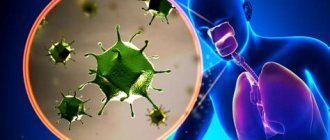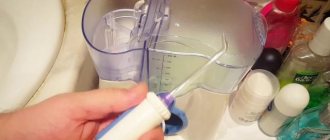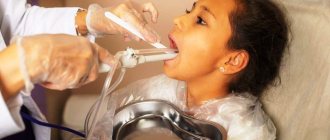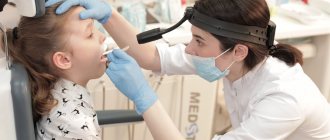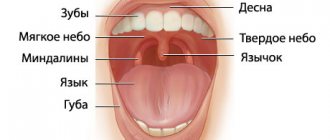Why do you need to rinse your tonsils?
The palatine tonsils are an organ of the human immune system. They are located at the very entrance to the pharynx on both sides. Outwardly, they resemble almonds. This similarity gave this organ its name. The tonsils consist of a large number of winding canals - crypts. On the surface of the tonsils there are small depressions - lacunae. It is in them that tonsillitis plugs accumulate, which are removed by washing.
Our tonsils act like a filter. They filter everything that enters the oral cavity from outside. And if infectious flora gets on the surface of the tonsils, they begin to produce lymphocytes - cells of the immune system that begin to fight the “enemy”.
If the body's defenses are not enough to cope with viruses and bacteria, an inflammatory process (chronic tonsillitis) starts in the palatine tonsils. In the gaps, pathogenic microflora is activated, the remains of bacterial activity and dead leukocytes accumulate. This entire “mixture” is compressed and turns into white-yellow plugs on the tonsils, which are noticeable upon examination and emit an unpleasant odor. These plugs do not allow inflammation to subside, so sanitation of the tonsils is an important part of the treatment of chronic tonsillitis.
Often, rinsing is the only way to preserve the tonsils and avoid their removal.
What is rinsing the tonsils with the Tonsillor device?
This method combines three types of effects on the tonsils:
- Mechanical. Vacuum pressure helps expel purulent plugs from lacunae.
- Physiotherapeutic. Ultrasonic treatment of the affected lymphoid tissue disinfects, suppresses the activity of bacteria and other possible pathogenic microorganisms, and stops the inflammatory process. Ultrasound also improves blood flow to the ENT organs and microcirculation, which ensures deep penetration of the medicine into the tonsils.
- Medication. The use of saline solution or anesthetic serves to wash out purulent plugs. An antibiotic or glucocorticosteroid drug is then administered to combat local inflammation and infectious agents.
This combination of therapeutic effects, especially against the background of parallel drug therapy to strengthen the immune system, usually gives quick and long-term results.
Contraindications to the procedure
Properly performed sanitation of the tonsils is a highly effective procedure for chronic tonsillitis. But in some cases, the patient may be refused to undergo lavage. Contraindications to manipulation are:
- an infectious disease in the acute stage (here we are talking not only about inflammation of the tonsils, but about any inflammatory processes in the oropharynx. Even carious teeth can cause refusal to carry out the procedure, since during manipulation the infection can get to healthy tissues);
- oncological diseases;
- retinal diseases;
- first and last trimesters of pregnancy;
- diseases of the cardiovascular system;
- high blood pressure;
- children under three years old;
- individual intolerance to the solutions used for washing.
In other cases, washing the palatine tonsils, carried out by a competent ENT doctor, gives an excellent result and allows you to achieve long-term remission when the symptoms of the disease do not bother you. The procedure is safe and well tolerated by patients. And most importantly, a high-quality procedure allows you to save the tonsils and avoid surgery to remove them.
There are several methods for carrying out the procedure: sanitation using a syringe and the vacuum method of washing the tonsils.
Who is recommended to wash the tonsils with the Tonsillor device?
The main indication for ENT procedures is tonsillitis . This is an acute or chronic disease of the tonsils of an infectious nature.
The developmental features and difficulties of treating this pathology are due to the structural specificity of the tonsils. The presence in them of a large number of depressions (crypts, or lacunae) actually serves the good purpose of increasing the surface of this paired organ - a barrier to infections entering the body. But it is precisely this property of the tonsils that causes the accumulation of pathogenic bacteria in them. The warm and humid climate of lymphoid “gorges” that are difficult to rinse is simply ideal for the growth of colonies of cocci, staphylococci and streptococci.
That is why acute tonsillitis easily turns into chronic, when the source of infection in the depths of the tonsils becomes permanent. The chronic form of the pathology is characterized by:
- frequent exacerbations (at the slightest cooling), tendency to sore throats;
- bad breath, periodic release of lumps of pus;
- soreness and increased size of the tonsils themselves and often visible whitish-yellowish deposits on their surface;
- intoxication of the body, since harmful waste products of pyogenic bacteria are carried by the bloodstream throughout the body, which can cause complications in the heart, kidneys, joints, provoking the development of myocarditis, pyelonephritis, arthritis, etc.
Attempts to treat tonsillitis by taking antibiotics, rinsing, and treating with antibacterial drugs are usually ineffective due to the hidden source of infection deep in the lymphoid tissue. Therefore, ENT rinsing of the tonsils is prescribed as the most productive method.
In addition, vacuum washing of the tonsils can be prescribed for ENT pathologies such as tonsillitis, rhinitis, adenoiditis, pharyngitis . Sanitation of the tonsils using the vacuum method is also carried out after removal of various tumors in the mouth and throat, including papillomas.
Syringe method
This is the most common and accessible method of performing the procedure. And most likely, when you go to the district clinic, you will be offered exactly this.
To carry out the procedure, a needle-free syringe with a curved cannula attached to it is used. An antiseptic solution, for example, a furatsilin solution, is drawn into the syringe. The syringe directs a stream of solution directly into the lacuna. The jet “breaks” the tonsillitis plug. Purulent masses, washed out of the lacunae by the solution, enter the mouth. At this moment, the patient must spit the washing solution into a special tray along with the washed purulent contents. As soon as the manipulation is completed, the surface of the tonsils is lubricated with Lugol's solution.
This method is referred to as the old, “grandfather” methods. Yes, this method is inexpensive, but it cannot be called very effective either. With this technique it is impossible to completely rinse the tonsils and remove deeply located caseous masses. Also, such sanitation requires good professional training from the otolaryngologist. An inexperienced ENT doctor can injure the surface of the tonsils with a syringe, which will lead to the spread of infection to healthy tissue, which will only worsen the situation.
The apparent simplicity of performing such a flush convinces patients to buy a syringe at a pharmacy and try to carry out the procedure at home. But only a few manage to cope. Firstly, we should not forget about the traumatic nature of the method, and secondly, it is not possible to maintain the proper level of sterility at home.
Sanitation with a syringe is an inexpensive and accessible method. But it is much more effective to carry out vacuum rinsing using the Tonzillor apparatus.
Who is contraindicated for washing the tonsils with the Tonzillor device?
In some cases, washing the lacunae of the tonsils with the Tonzillor device may be contraindicated or should be carried out with caution under the especially vigilant supervision of a physician. Contraindications include:
- acute course of an ENT disease, accompanied by fever and severe inflammation;
- acute respiratory viral diseases, including influenza, covid, etc.;
- severe tuberculosis;
- some ophthalmological diseases associated with ruptures and weakness, retinal dystrophy;
- individual intolerance to drugs used during the procedure;
- the presence of malignant tumors, no matter in what part of the body;
- III degree of hypertension;
- problems with blood clotting;
- the first three and last three months of pregnancy;
- children up to three years of age.
Vacuum method
To carry out the manipulation, an ultrasonic device “Tonsillor” is used. As standard, the device comes with a vacuum nozzle for washing gland lacunae. At the beginning of the manipulation, the ENT doctor performs topical anesthesia of the palatine tonsils with a solution of Lidocaine. The patient sits comfortably in a chair and opens his mouth.
The vacuum nozzle is brought to the surface of the tonsils and attached to it. The washing solution is fed through a nozzle, passes through the gaps and, under pressure, washes out all the pathogenic contents from them. Antiseptic or saline solutions are used as flushing solutions. The solution passes through the thickness of the tonsil once and is not reused, since after washing it is removed into a special suction.
Since the waste solution goes directly into the suction, infection of healthy tissues during the manipulation is excluded.
The procedure is carried out under the influence of ultrasonic vibrations, which allows the medicine to penetrate deeper layers of tissue, and this contributes to a rapid recovery.
In general, the procedure on the Tonsillor apparatus resembles the principle of operation of a vacuum cleaner. This vacuum sanitation allows you to effectively clean the lacunae of the tonsils and get rid of purulent accumulations.
On average, five to ten sessions are required to achieve a lasting therapeutic effect.
At this point we could put a full stop and end the article. But there is another way to carry out vacuum rinsing - using a modified attachment of the Tonsillor device, which is used only in the ENT Clinic of Doctor Zaitsev.
How is the tonsils washed with the Tonsillor device?
This method is distinguished by its gentle effect on the palatine tonsils, compared to surgery and even rinsing with a syringe. And yet, some patients are afraid of hardware treatment, assuming that it is painful. Such fears are unfounded.
Unpleasant sensations are relieved by first applying an anesthetic solution to the affected area, which weakens sensitivity and prevents the occurrence of a gag reflex.
Then, using a nozzle operating in vacuum cleaning mode, the purulent contents are drawn out from the lacunae. Then comes the turn of ultrasonic treatment in combination with washing with saline solution or an antiseptic (furatsilin, miramistin, etc.) and administration of drugs.
A session of washing the lacunae of the tonsils with the Tonzillor apparatus lasts no more than 10 minutes. Patients usually feel relief after the first time. For most patients, 5–10 sessions are enough to forget about the disease for a long time. If necessary, the course can be repeated after six months.
What should you be prepared for when undergoing hardware treatment for tonsils? Firstly, after each session for 3-4 hours, slight soreness may be felt in the throat due to the cessation of the anesthetic effect. It is better not to drink or eat for at least an hour. By the way, for the entire period of therapy you should avoid foods and drinks that irritate the mucous membranes. Spicy, rough, too hot or cold food is not advisable. Secondly, plugs often come off not only during the cleaning process, but also in the intervals between procedures; there is no need to be afraid of this.
Flushing efficiency
The function of the tonsils is to protect the body from harmful pathogenic microorganisms and dust that fall on them from passing air, food or liquid. In a healthy person, lymphocytes matured in the folds of the tonsils destroy pathogenic agents, and then the surface is cleaned independently. The weakening of the immune defense leads to the fact that the tonsils are not cleansed and pus accumulates in the lacunae. The effectiveness of washing the lacunar folds, according to ENT doctors, is much higher than that of gargling, which many are accustomed to. The procedure provides:
- cleansing gaps from the accumulation of pathogenic microflora;
- reduction of symptoms of intoxication after removal of purulent exudate;
- preventing the spread of the infectious process to nearby tissues;
- reducing the risk of complications due to inflammation of the tonsils.
For chronic tonsillitis, a course of lavage becomes an alternative to removing the tonsils. Regular cleansing of the tonsils mechanically allows you to achieve stable remission and gradually restore the natural protective functions of the organ.
Washing the tonsils with the Tonsillor apparatus for children
Before the age of five, hardware lavage of the tonsils is rarely prescribed due to the psychological unpreparedness of children. After all, anesthesia for this procedure is not justified, but it is extremely important that the patient remains motionless. Small children are not capable of this. And even after five years, it is very important to set the child up correctly so that he is not afraid and behaves calmly.
Causes
The etiology and pathogenesis of chronic tonsillitis has not been fully studied to date.
The starting mechanism in the development of chronic tonsillitis is repeated inflammatory processes leading to local immunosuppression.
- Local causes are infectious foci (carious teeth, purulent sinusitis, etc.).
- Pathogenic and opportunistic microorganisms.
- Immunodeficiency states.
- Persistent violation of nasal breathing (adenoids in children, deviated nasal septum, etc.).
- Allergic sensitization of the body.
What needs to be done first?
Before starting treatment procedures, it is recommended to visit an otolaryngologist. You may also need to undergo the following examinations:
- general blood analysis,
- bacteriological examination of the tonsil area,
- rheumatic tests.
To avoid possible discomfort caused by the gag reflex, it is strongly recommended to carry out the procedure on an empty stomach. That is, the last meal and water should be taken at least 3 hours before visiting the clinic. And after washing the tonsils, you must not eat or drink for another 40-60 minutes for the treatment to proceed properly.
More accurate information can always be obtained by making an appointment by phone.
What is this procedure?
Tonsilor is a special device that came into the arsenal of otorhinolaryngologists several years ago, but has already proven its undeniable effectiveness. The method is based on the vacuum effect on the pathological contents of the lacunae of the tonsils. Tonsilor rinsing can be carried out even in an outpatient clinic; it is enough that the doctor has the necessary equipment and sufficient experience.
To be completely confident in safety and guaranteed results, make an appointment at a diagnostic and treatment center in Moscow. Our specialists will cope with the task quickly and efficiently!
Our clinic constantly hosts promotions
Washing of tonsil lacunae: price
One session of hardware washing of tonsil lacunae will cost you only 300 rubles. As a result, even for a 10-day course you will spend the same amount that you regularly leave at the pharmacy, unsuccessfully fighting chronic tonsillitis with medicinal methods. Only now the efficiency will be many times higher!
Remember that chronic tonsillitis is an insidious pathology, fraught with systemic complications from a number of organs and systems. Therefore, it is worth getting rid of it as soon as possible. This will be done by specialists from the Healthy Children MC at st. Sverdlova, 4 and MC “Secrets of Longevity” at Druzhby, 21.
You can make an appointment by phone (Sverdlov St., 4), (Druzhby St., 21).
Diagnostics
THE INSTITUTE OF ALLERGOLOGY AND CLINICAL IMMUNOLOGY has a fundamental base that allows it to carry out the full range of diagnostic and therapeutic measures for any form of allergy that meets the level of international standards. Many of the diagnostic and treatment methods were developed by the staff of our Institute.
Diagnostic measures are based on anamnesis, clinical picture and laboratory diagnostics.
- Bacteriological examination of mucus from the tonsils and posterior pharyngeal wall for aerobic and facultative anaerobic microorganisms.
- Determination of the sensitivity of microorganisms to antibiotics and other drugs.
- Detailed general (clinical) blood test, clinical urine test.
- Determination of the concentration of C-reactive protein in blood serum.
- Determination of antistreptolysin-O in blood serum.
